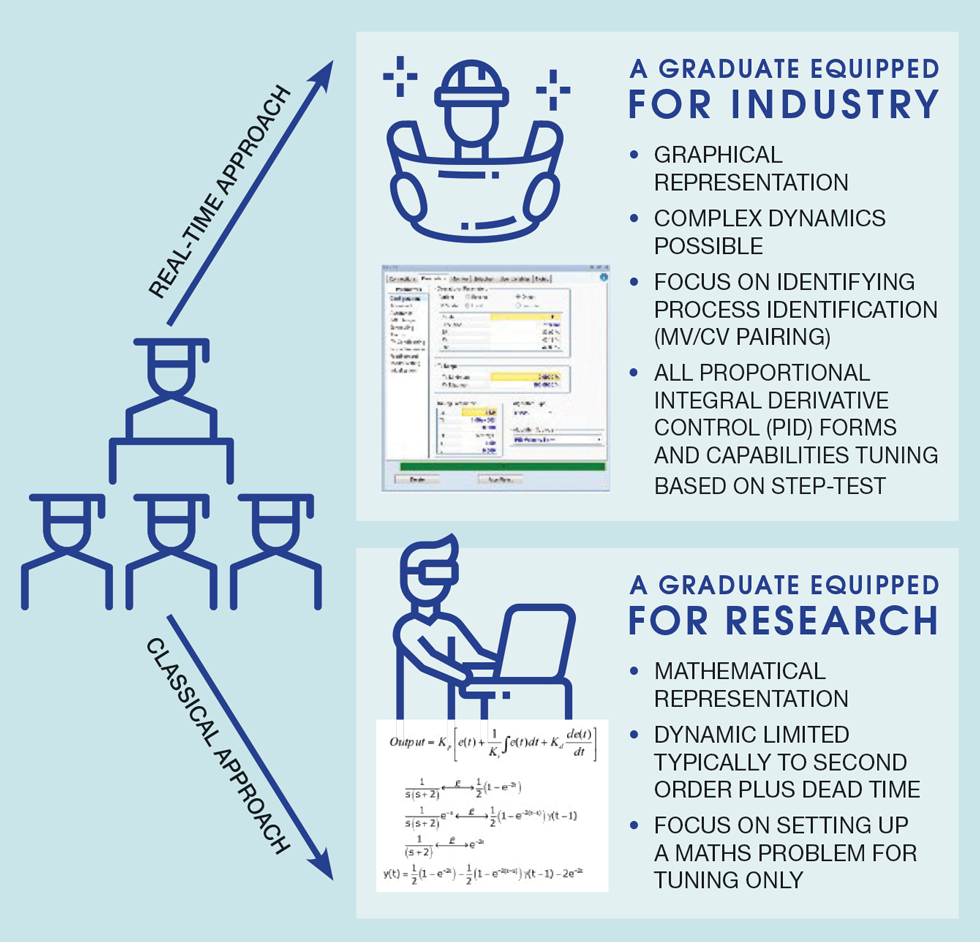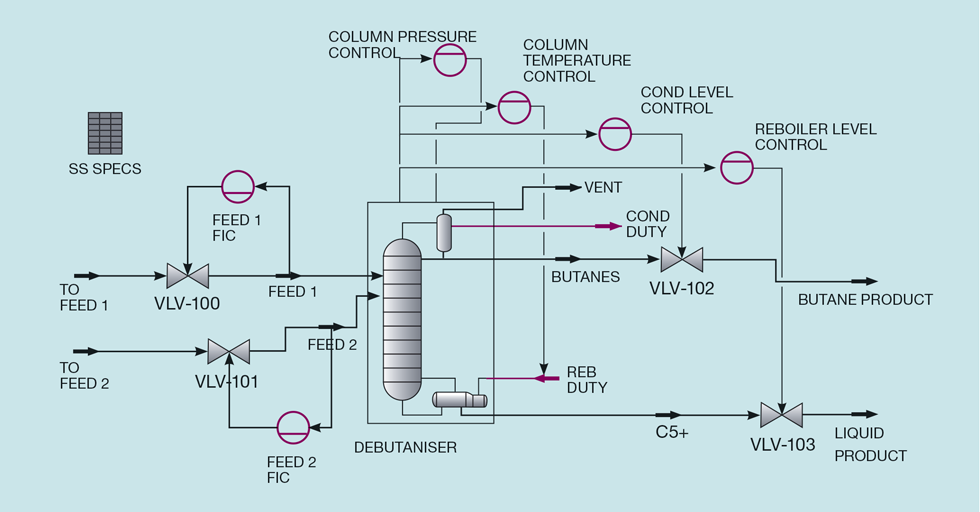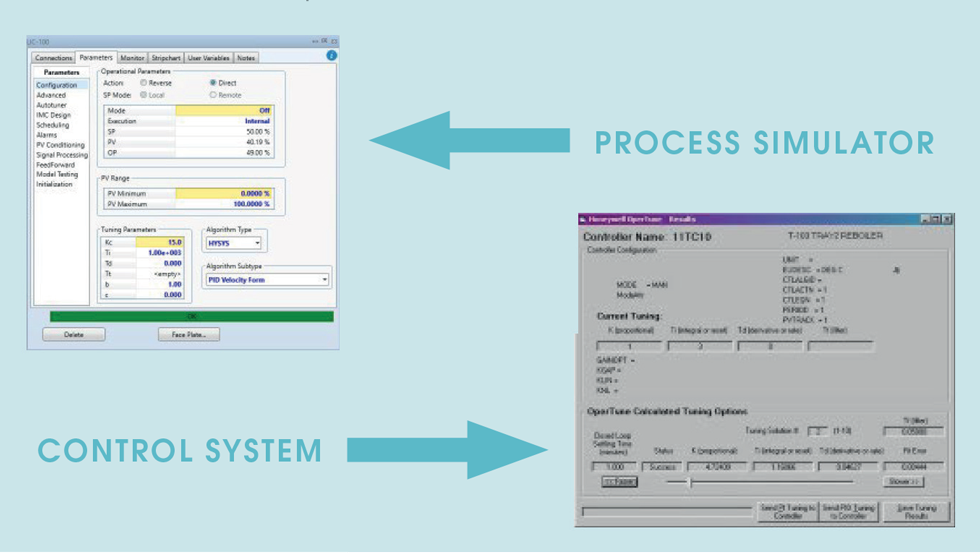A Digital-Twin Approach to Distillation Control Education
DIGITAL tools, like industrial process simulators, have greatly matured and become ubiquitous over time. However, undergraduate (and postgraduate) courses rely heavily on complex mathematical equations, which can make students focus on learning how to solve mathematics problems over learning the core chemical engineering principles behind them. A case in point is process control, which often still relies on classical mathematical concepts taught in engineering programmes for solving dynamics analytically such as Laplace transforms. While these concepts may provide a theoretical foundation for students interested in process control, they fall short of demonstrating how to design control structures in a real-world industrial setting.
To address this gap, the authors developed a digital twin-based education approach that emphasises a hands-on learning paradigm, using real-time simulations to demonstrate distillation control concepts. Figure 1 illustrates the key benefits of the approach, which is to equip students (both undergraduates and post-grads) to be better equipped to tackle complex control problems faced in the industry.

The emergence of digitalisation and Industry 4.0 has prompted industries worldwide to reconsider how these concepts can be incorporated into their operations and business models. Distillation is a vital process in the chemical process industry, accounting for over 40% of total energy usage in a plant1. The efficient operation of a distillation process requires the management of both mass and energy balances2. Control engineers have developed basic control configurations and worked on more complicated distillation processes, eg, high-purity distillation3. The use of industrial process simulations as a test bed for developing and testing new or updated control configurations has been advocated by some researchers for decades4. Today, these simulations can be considered digital-twin models, a core concept in the overall drive towards digitalisation. Despite this, many academics still rely on the concepts such as Laplace transforms to teach the complex subject of distillation control. The reasons for this are that they’re elegant analytical methods that can be taught traditionally via a lecture, tutorial, quiz approach. However, this ignores important non-linearities present in complex distillation operations, making it difficult for students to understand underlying process dynamics and apply controls to solve real-world control problems.
The real-time approach proposes an alternative digital model-based way to both teach and learn. We and others globally have used it for general chemical process control education for over two decades5, and now specifically for distillation process control. The outline and core modules of the real-time approach for distillation process control are as follows:
- An introduction to distillation processes and process control, discussing real-time control and its benefits in education
- Chemical engineering fundamentals of distillation operations and control configurations
- Control hardware, covering sensors, final control elements, and distributed control systems hierarchy
- Pressure and level controls for inventory control
- Temperature-based control configurations for composition control
- Practical differences between refinery and chemical distillation columns
- Distillation control tuning
- Fine and specialty chemical distillation controls
- Advanced regulatory control applications
- Model predictive control and its specific distillation applications
- Control configurations for distillation trains
Each module provides practical aspects for consideration in industrial settings, such as managing non-linearities in inventory control and final control elements, which are oft overlooked or minimised in classical approaches. A key concept of the approach is to enable prospective learners to gain a practical understanding of how process control concepts are applied in an industrial setting. To this end, four workshops were developed.
In these workshops the participants model progressively complicated distillation configurations on an industrial process simulator. These configurations are digital representations of typical process units found in industry and behave similarly. The workshops are written such that they’re “simulator agnostic” (ie, learners are free to choose the most convenient simulator for them).
The first workshop is about hands-on learning and focuses on getting the participants to develop a working knowledge and understanding of the fundamentals of both steady state and dynamic process simulations. A key task in this workshop is transitioning a process model from a steady state to dynamics.
The second workshop focuses on fundamental distillation column control, building upon the first workshop to develop a dynamic model of a simple C4/C5 splitter. This demonstrates the impact the selection of a control strategy has on the operability and controllability of simple distillation columns. A key task in this workshop is the model-aided investigation of process dynamics. This type of dynamic investigation forms the core of many model-identification exercises, where step tests can be performed to understand the dynamic behaviour of a distillation column. Another task is the implementation of base layer inventory control structures, which are required to stabilise the digital model, which, like a physical distillation column, is unstable without these controls. Figure 2 shows a schematic of all the stabilising controls and other base layer controls that are implemented in workshop two (in this case implemented in Aspen HYSYS).
The third workshop focuses on distillation column model predictive control and builds on the dynamic model and the base layer control structure developed in workshop two. Here, further step tests are performed on the dynamic model and the results are then used to set up a Model Predictive Controller (MPC). Dedicated MPC modules can be found in industrial process simulators. Typically, the process models in these MPCs can be set up to be first order models which approximate the behaviour of a given distillation process. In this workshop the participants are instructed to take the results of the step tests and determine the model parameters for process gain, time constant, and dead time. It should be noted that the MPC control modules found in industrial process simulators are similar to those in industrial MPC applications. Hence, someone trained on an industrial process simulator may have an easier time implementing MPC on an industrial system compared to someone implementing MPC using a computer programming language, eg, Python, C++, etc.
Using an industrial process simulator to teach distillation control reduces the gap between classroom learning and industrial practice, increases the fidelity of the models, and allows for the testing of digital models as a test bed
The fourth workshop involves distillation column control in a plantwide setting and focuses on the control of an isomerisation process which includes distillation columns. The key objective here is to teach the participant how to use the steps of a plant-wide process control design procedure to design a robust process control strategy for an entire process, rather than just a single unit operation. This workshop requires the participant to develop an overall process model consisting of multiple distillation columns, a reactor and heat exchanger (including a furnace), and multiple process recycle loops, and to operate this process dynamically. Developing such a digital model of a process also means the participant will develop additional, industrially relevant, process modelling skills.
The transition of teaching distillation control from theory to a digital model-enabled method has its benefits and challenges. On the one hand, using an industrial process simulator to teach distillation control reduces the gap between classroom learning and industrial practice, increases the fidelity of the models, and allows for the testing of digital models as a test bed. Participants can focus more on dynamic analysis and control structure implementation. However, there are specific challenges: the need for an industrial process simulator, training instructors to an advanced level, and the impracticality of implementing some control and tuning concepts in industrial settings.
In conclusion, while the benefits of using a digital model-enabled method in teaching distillation control are significant, instructors and participants must also be aware of the challenges and limitations of reducing the gap between what is taught in a classroom and what participants are expected to do in industrial settings. For example, when setting up a PID or an MPC controller in an industrial process simulator, the participant must “configure” the PID controllers as shown in Figure 2. This includes specifying the type of action (direct or reverse), process variable measurement spans, control valves (or other final control elements), and other related characteristics. The students then enter the relevant tuning constants.

When comparing these actions to industrial control systems configuration as shown in Figure 3 (Honeywell control builder), similarities become apparent.

The proposed approach is a much-needed enhancement to how distillation control is taught and leverages heavily on the emerging trend of using digital twins in process industries. The key benefit of the proposed approach to learners is the removal of the barrier between control theory and control practice which is enabled by a realistic learning environment.
Reactions from the students to the real-time approach have been overwhelmingly good. Since the introduction of a real-time approach to process control in general at the University of Calgary, Canada we have had consistently high Likert scores in student ratings of instruction for over two decades, typically above average for the department, with students noting the difference in approaches to solely classical analytical methods in the free-form comments. The real-time approach to distillation process control has been introduced as a key component of a new Industry 4.0 for chemical engineering elective course at the University of Auckland, New Zealand three years ago, which is also proving popular with students who are recognising the need for simulation and coding skillsets.
Related to this later comment, the approach has been designed with industry surveys, direct industry feedback, and industrial ways of working in mind for now and into the future, as well as push from accreditation such as IChemE to include more and relevant digitalisation content such as digital twins. For those interested in gaining the experience and skills to teach this new approach, we recommend forming partnerships with industry. There are also good resources in the help files of the process simulation tools (both open source and commercial) that enable one start easily and painlessly.
Putting ourselves in your shoes as fellow teachers/instructors, our advice is to learn by doing like our students. Simulation and the development of digital twins is fun and a necessary and sought-after accredited skill for distillation process control.
This is the third in a series of articles in which colleagues will explore various aspects of digitalisation of engineering education in more detail.
References
1. US Department of Energy. Distillation Column Modeling Tools (2001). https://bit.ly/47myPGo
2. Young BR, et al. A Real-time Approach to Distillation Process Control 1st ed (2023). Wiley.
3. Udugama IA, et al. Side draw control design for a high purity multi-component distillation column. ISA Trans 2018;76:167-177.
4. Young BR, et al. The Application of HYSYS Steady State and Dynamic Simulation for Process Control Design of a Distillation Column with Side-Stripper. CHEMECA 1996:145–50.
5. Svrcek WY, et al. A Real-time Approach to Process Control 1st ed (2000). Wiley.
Recent Editions
Catch up on the latest news, views and jobs from The Chemical Engineer. Below are the four latest issues. View a wider selection of the archive from within the Magazine section of this site.




